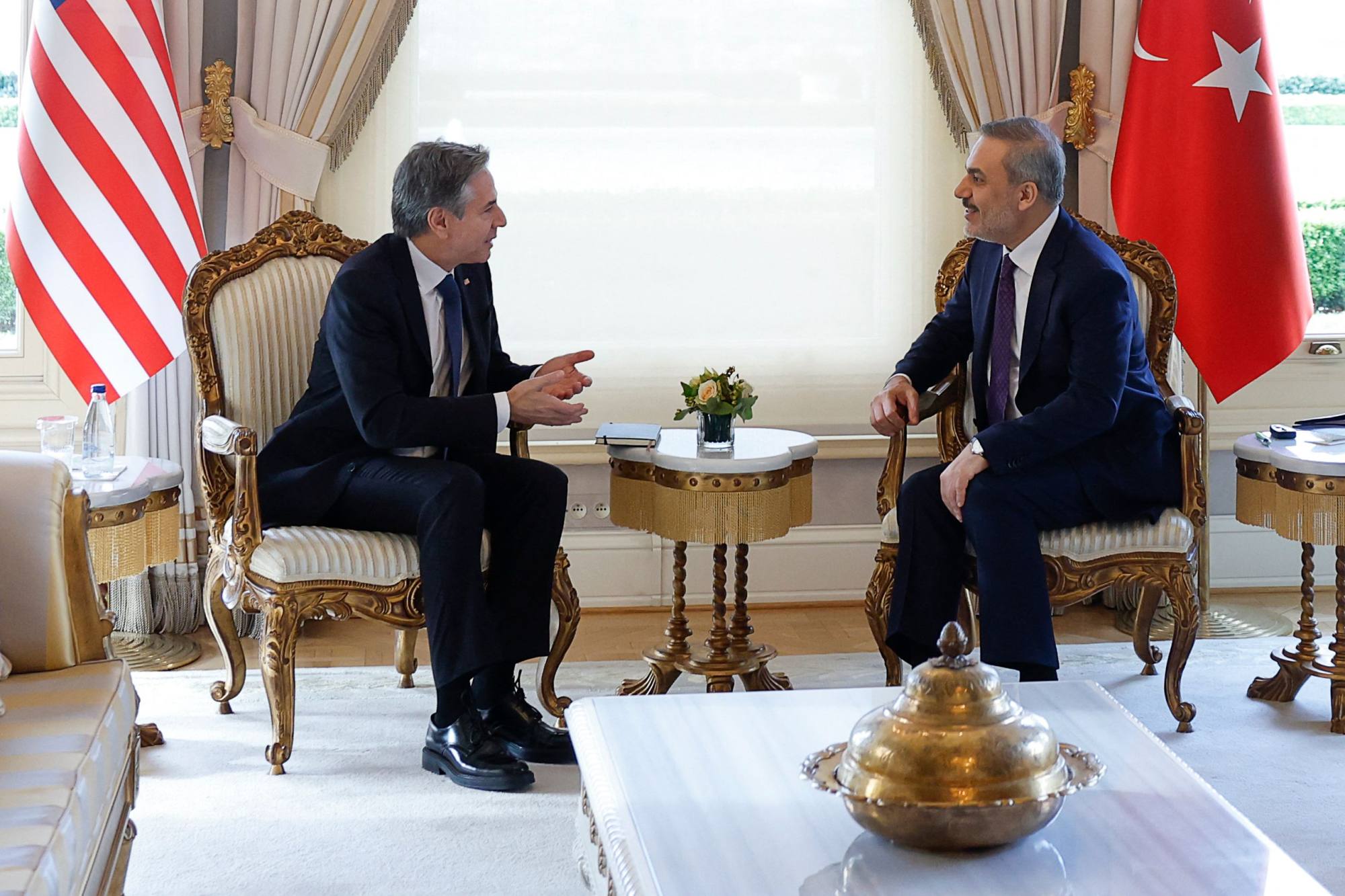
Israel, Hezbollah exchange fire across Lebanon border amid alarm over Gaza war spillover
- Hezbollah hit a key Israeli observation post with 62 rockets as a ‘preliminary response’ to the killing of Hamas’ deputy chief Saleh al-Arouri, as Israel retaliated by striking a ‘terrorist cell’
- Top US and EU officials begin new push to contain the war, stressing the need to work towards broader, lasting regional peace and keep diplomatic channels open
Lebanon’s Iranian-backed Hezbollah group said on Saturday it had fired rockets at Israel and its arch-foe said it had struck a “terrorist cell” in retaliation, as top US and EU diplomats visited the region to seek ways to halt spillover from the war.
Fighting also raged on inside Gaza, especially in and near the southern city of Khan Younis, where the Israeli military said it killed three members of the militant Palestinian Hamas group which has run the densely populated coastal strip.
US Secretary of State Antony Blinken and the European Union’s top diplomat Josep Borrell were both in the region on separate diplomatic missions to try to quell spillover from the three-month-old Gaza war into Lebanon, the Israeli-occupied West Bank, and Red Sea shipping lanes.
Israel and Hezbollah often trade fire across the Lebanese border, the West Bank is seething with emotion and the Iran-aligned Houthis in Yemen seem determined to continue attacks on Red Sea shipping lanes until Israel stops bombarding Gaza.

Rocket sirens resounded across northern Israel early on Saturday when the Israeli military said some 40 “launches” from Lebanon towards the area of Meron were identified.
There were no reports of casualties or damage.
Hezbollah said it had hit a key Israeli observation post with 62 rockets as a “preliminary response” to the killing of Hamas’ deputy chief Saleh al-Arouri on Tuesday.
Tensions have been especially high in the area since Arouri was killed by a drone in the southern suburbs of Beirut, a stronghold of Hamas’ Lebanese ally Hezbollah, in an attack widely attributed to Israel.
Lebanon’s Jama’a Islamiya Islamist group said it had also fired two volleys of rockets on Saturday at Kiryat Shmona in northern Israel, in the third operation claimed by the militant Sunni group since October 7.
Israel’s military said it responded to the rocket attacks with an unmanned aerial vehicle (UAV) strike on “the terrorist cell responsible for the launches”.
Israeli fighter jets and troops also struck a series of Hezbollah targets in the areas of Ayta ash Shab, Yaroun, and Ramyeh in southern Lebanon, it said, hitting a launch post, military sites, and “terrorist infrastructure”.

Blinken was meeting the leaders of Turkey and Greece on Saturday at the start of a week-long trip that will also take him to Israel, the Israeli-occupied West Bank, Jordan, Qatar, the United Arab Emirates, Saudi Arabia and Egypt.
In Istanbul, Blinken held talks with Turkish Foreign Minister Hakan Fidan and then with President Recep Tayyip Erdogan, a fierce critic of Israel’s military actions in Gaza. Turkey, which unlike most of its Nato allies does not class Hamas as a terrorist organisation and hosts some of its members, has offered to mediate in the Gaza conflict.
In the talks, Blinken “emphasised the need to prevent the conflict from spreading, secure the release of hostages, expand humanitarian assistance and reduce civilian casualties”, US State Department spokesman Matthew Miller said.
Blinken also stressed the need to work towards broader, lasting regional peace that ensures Israel’s security and advances the establishment of a Palestinian state, he said.

The EU’s senior diplomat Borrell, visiting the Lebanese capital Beirut, expressed alarm about the exchange of fire between Israel and Hezbollah and said it was important that Lebanon not be dragged into the Gaza conflict.
“Diplomatic channels have to stay open. War is not the only option – it’s the worst option,” Borrell said.
Israel’s onslaught began after Hamas militants from Gaza attacked Israel on October 7, with 1,200 people killed and 240 taken hostage, according to Israeli officials.
The offensive, aimed at wiping out Hamas, has so far killed 22,722 people, according to Palestinian health officials, and devastated the tiny enclave of 2.3 million people. At least 122 Palestinians have been killed and 256 others injured in Gaza in the past 24 hours alone, they said on Saturday.
The official Palestinian WAFA news agency reported on Saturday that 18 Palestinians were killed by an Israeli attack on a house east of Khan Younis in southern Gaza.

The Palestinian Red Crescent reported heavy shelling inside Khan Younis near the Al-Amal Hospital. Shrapnel flew into the medical facility amid the sound of heavy gunfire from drones, it said in a post on social media platform X.
The Israeli military said its commandos had killed three militants near a school in Bani Suheila in the city.
“The soldiers encountered the terrorists, returned fire and eliminated three terrorists who were found with RPG missiles,” the military said. “In a civilian house, the forces located many weapons, grenades, magazines and vests that were used by Hamas.”
The traumatised residents of Gaza, most of whose population has been displaced by the bombardment, are wrestling with chronic shortages of food, medicine and fuel supplies.

Standing outside a morgue in Khan Younis on Saturday, 11-year-old Mahmoud Awad said his parents and siblings had been killed by Israeli airstrikes.
“We were in al-Shati refugee camp and they [Israeli army] dropped fliers saying that Gaza is a battlefield, so we fled to Khan Younis because it was a safe place, and they still bombed us,” he said.
Israel denies targeting civilians but says Hamas militants deliberately embed themselves and their infrastructure among civilian populations to make it harder for Israeli forces to strike.
Hamas, which is backed by Iran and is sworn to Israel’s destruction, denies the accusation.

